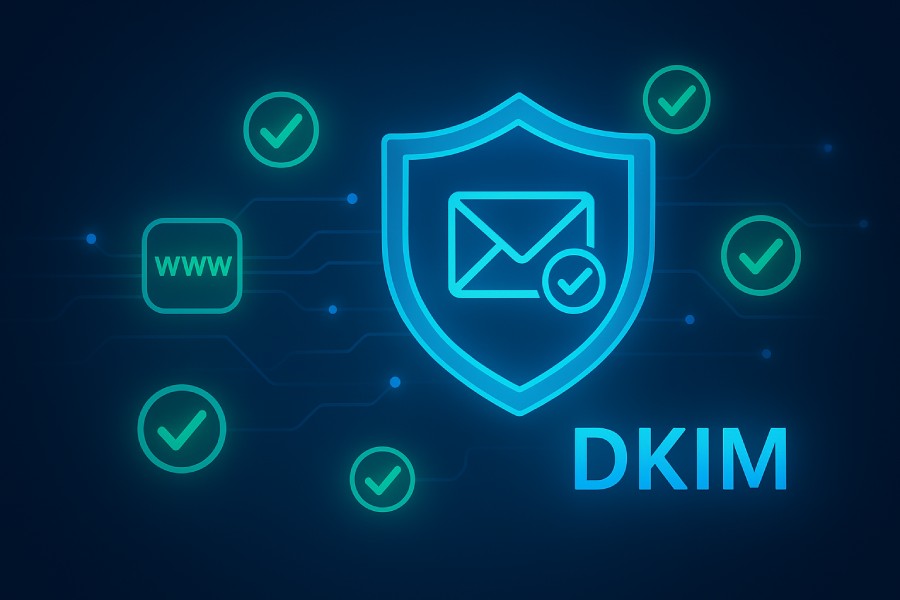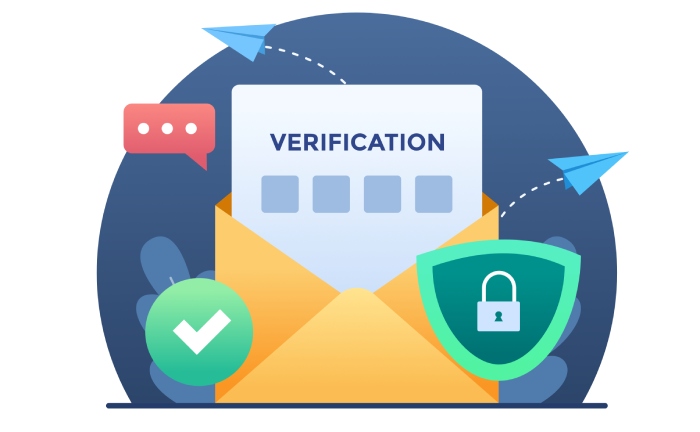DomainKeys Identified Mail (DKIM) is a critical component of modern email authentication frameworks. As email threats such as phishing and spoofing continue to increase, leveraging a DKIM signature checker has become indispensable for organizations aiming to protect their domain reputation and ensure email deliverability.
A DKIM checker validates the presence and correctness of a DKIM record in your DNS TXT records and verifies the cryptographic signature applied to outgoing email messages. In this section, we explore four primary ways a DKIM signature checker enhances your domain reputation.
Way #1: Ensures Authenticity of Outgoing Emails
Ensuring the authenticity of outgoing emails is foundational to maintaining trust between a sender and their recipients. When an organization implements DomainKeys Identified Mail (DKIM) signing, each outgoing email message is stamped with a unique cryptographic signature—known as a DKIM signature—that is directly linked to the sender’s domain name and the email content itself.
This digital signature is generated using a private key that signs specific headers and the body of the message, thereby establishing domain-level authentication. Once sent, the recipient’s mail server can use the corresponding public key—stored in the sender’s DNS record—to verify that the message hasn’t been tampered with during transit.
How a DKIM Signature Checker Validates Authenticity
A DKIM signature checker plays a pivotal role in verifying the authenticity and integrity of outbound messages. The checker performs a DKIM lookup and validation process by querying the DNS TXT record that contains the public key associated with the specific DKIM selector prefix.
The DKIM selector, embedded within the DKIM-Signature email header, directs the validation tool to the correct DNS entry, allowing retrieval of the corresponding public key for verification. This process ensures that:
1. The Email Remains Unaltered During Transmission
By validating the cryptographic hash against the retrieved public key, a DKIM checker confirms that the email’s header and body content have not been modified since they were signed. This reinforces email integrity and prevents unauthorized alterations.
2. The Domain Ownership is Verified
Successful validation confirms that the sender’s domain legitimately owns the DKIM key pair. This validation builds trust and accountability between senders and recipients, ensuring emails originate from verified sources.
Maintaining Trust and Security Through Continuous Validation
By conducting regular DKIM checks on outgoing emails, organizations can proactively confirm message authenticity before delivery. Public key retrieval via a DKIM record checker also ensures DNS configurations remain accurate and current.
Industry leaders like Google and Microsoft emphasize DKIM as an essential part of modern email authentication frameworks (alongside SPF and DMARC). Using specialized tools such as EasyDMARC or MXToolbox’s DKIM Record Checker automates the verification process, minimizes human error, and helps prevent email spoofing or tampering—ultimately strengthening domain reputation and overall email security.
Way #2: Detects Misconfigurations Before Sending
Misconfigured DKIM records or selector prefixes can hinder email authentication and damage sender reputation. A subtle syntax error within the DKIM record, such as an incorrect format in the DNS TXT record or an outdated RSA public key, could result in failed DKIM validation and poor domain reputation.
A DKIM checker is essential in proactively detecting these misconfigurations before they impact email deliverability or domain reputation. By running a DKIM record check, organizations can verify the syntax correctness of their DKIM record, ensure proper association of DKIM selectors, and confirm the presence of the valid public/private key pair in the DNS.
Using a DKIM record generator can sometimes introduce errors, especially in complex DNS setups involving third-party email providers (ESPs) or hybrid email servers. A DKIM record checker helps detect mismatches between the email signing practices and the DKIM record published in DNS TXT entries. This validation covers DKIM syntax, the RSA key length, and selector prefixes, aligning them with industry standards such as DKIM1.
DKIM lookups allow IT administrators to conduct DNS queries on their domain’s DNS records, verifying that the DKIM public key retrieval process works seamlessly during email processing. This reassures that emails will pass DKIM validation by recipient mail transfer agents (MTAs) like those employed by SendGrid, Google Workspace, or Microsoft 365.
Regular DKIM checks, integrated with email security tools and inbox placement tests, are proactive steps in maintaining domain reputation by catching invalid or missing DKIM signatures early.
Way #3: Prevents Email Spoofing and Phishing Attacks
Email spoofing and phishing attacks exploit vulnerabilities in email headers and domain impersonation techniques, deceiving recipients into trusting fraudulent messages. Implementing DomainKeys Identified Mail (DKIM) serves as a critical barrier against these malicious tactics, ensuring that only emails verified with valid cryptographic signatures from authorized domains reach recipients’ inboxes.
1. How DKIM Fights Email Spoofing
DKIM embeds a unique, domain-linked cryptographic signature within every outgoing email. This signature allows receiving mail servers to authenticate the message origin, confirming it hasn’t been altered during transmission.
Role of a DKIM Signature Checker
A DKIM signature checker detects emails with missing, invalid, or mismatched signatures. This verification process helps organizations ensure their emails are genuine and protected from impersonation attempts. By validating DKIM records continuously, businesses strengthen their domain reputation and reduce the likelihood of messages being flagged as fraudulent or suspicious.
2. Building a Multi-Layered Email Authentication Framework
DKIM operates most effectively when integrated with SPF (Sender Policy Framework) and DMARC (Domain-based Message Authentication, Reporting, and Conformance) policies. Together, they create a comprehensive defense system for email authentication.
Integrating DKIM with Other Email Security Tools
Organizations can utilize platforms such as EasyDMARC and EasySPF to manage DKIM, SPF, and DMARC collectively. Additionally, tools like the BIMI Record Checker enhance brand credibility and visibility by displaying verified brand indicators in recipient inboxes—reinforcing trust and deterring phishing attempts.
3. Detecting and Fixing DKIM Vulnerabilities
Even robust systems require regular inspection to maintain integrity.
Identifying Weak Keys and Misconfigurations
DKIM record checkers can reveal vulnerabilities like weak RSA keys, expired selectors, or misaligned domain signatures—all of which attackers might exploit for phishing. Continuous validation ensures DKIM signatures align with both email headers and body content, instantly identifying any form of tampering or unauthorized modification.
4. Strengthening Cybersecurity with Continuous DKIM Validation
As phishing attacks evolve in sophistication, proactive monitoring becomes indispensable.
Maintaining a Trusted Domain Reputation
Integrating DKIM checkers into your organization’s email security toolkit fortifies sender reputation, prevents domain spoofing, and upholds the integrity of your brand’s communications. Regular DKIM monitoring not only mitigates phishing risks but also reinforces a company’s commitment to secure and trustworthy digital correspondence.
Way #4: Enhances Deliverability Rates to Recipient Inboxes
A strong domain reputation directly impacts how successfully your emails land in recipient inboxes instead of spam folders. DKIM signing and validation ensure authenticated communication between sender and receiver, improving email deliverability and domain credibility.
When a sender uses a valid DKIM signature, the recipient’s mail server performs a DKIM lookup to verify authenticity using the public key from the domain’s DNS TXT record. A successful DKIM validation enhances the sender’s reputation and increases inbox placement rates.
A DKIM signature checker helps by simulating validation steps, detecting header misalignments, and verifying key configurations. Integration with email deliverability platforms (like Google Postmaster Tools, SendGrid, or Microsoft 365) provides further analytics on inbox placement and trust signals.
To maximize results, organizations should maintain secure key pairs, correct selector prefixes, and combine DKIM with SPF, DMARC, MTA-STS, TLS-RPT, and BIMI for a layered email authentication strategy.
📊 Summary Table: DKIM’s Role in Email Deliverability
| Factor | Description | Impact on Deliverability |
| DKIM Signing | Digitally signs emails using a private key | Verifies message authenticity |
| DKIM Lookup | Recipient fetches the sender’s public key from DNS | Confirms signature validity |
| Signature Checker Tools | Simulate DKIM validation and detect configuration issues | Prevent DKIM failures |
| Key Management | Use secure 2048-bit key pairs with proper selectors | Maintains trust and encryption integrity |
| Combined Protocols (SPF, DMARC, BIMI, etc.) | Multi-layered protection against spoofing | Strengthens domain reputation and inbox placement |
By implementing a DKIM signature checker for ongoing DKIM validation and DKIM record checks, businesses can protect their domain name and improve their email authentication processes significantly. This leads to better email security, higher deliverability rates, and a fortified defense against fraud and phishing attacks. For enhanced email security and sustained domain-level digital signature integrity, leveraging DKIM checkers and associated email security tools is an essential best practice in today’s cybersecurity landscape.
Way #5: Builds Trust with Email Service Providers (ESPs)
Enhancing Domain Credibility with ESPs
One of the most critical advantages of performing a DKIM check is its ability to strengthen the trust relationship between your domain and leading Email Service Providers (ESPs) such as Google, Microsoft, and SendGrid. These providers rely on domain-level digital signatures embedded within email headers to validate the authenticity of the sender.
A properly configured DKIM record acts as a cryptographic signature attached by the sending mail server. This signature allows ESPs to confirm that the message truly originates from the authorized domain, thereby preventing impersonation or tampering during transmission.
How ESPs Verify DKIM Signatures
When an ESP receives an email, it performs a DKIM lookup by querying the sender’s DNS TXT record, which contains the public key associated with the domain’s DKIM selector.
If the DKIM signature within the email matches this public key, it verifies that:
- The email content has not been altered in transit.
- The message genuinely comes from the claimed domain.
This authentication process builds a foundation of trust, which enhances sender reputation and boosts inbox placement, ultimately improving overall email deliverability rates.
Importance of Using DKIM Record Check Tools
- To ensure error-free configuration, administrators can utilize tools like EasyDMARC, MXToolbox, or DKIM record checkers available through SourceForge.
- These platforms help verify that the DKIM syntax is correct and that the public/private key pair is accurately deployed.
- Maintaining precision in DKIM record setup ensures that every outgoing message is digitally signed according to industry standards.
Strengthening Domain Reputation Across ESP Networks
When ESPs consistently detect valid DKIM signatures, they are more likely to classify your emails as legitimate and secure. This reduces the risk of messages being flagged as spam or rejected during filtering.
Additionally, third-party mail transfer agents (MTAs) and store-and-forward email services also rely on DKIM authentication to validate message origins. A consistent record of successful DKIM validation helps establish a trustworthy sending pattern, encouraging ESPs and intermediaries alike to treat your domain as a reliable email source.
Building Long-Term Trust and Deliverability
Ultimately, DKIM validation serves as a long-term trust mechanism between your domain and the global email ecosystem. It not only protects your brand from spoofing and phishing but also enhances email protection, sender credibility, and delivery success, ensuring your messages consistently reach intended inboxes.
Way #6: Provides Insight into DKIM Key Rotation Needs
Regular DKIM checks provide valuable insight into when a domain should perform DKIM key rotation, an essential security practice that strengthens your email authentication framework. Key rotation refers to the periodic replacement of the cryptographic private key used to sign outgoing messages, ensuring long-term resilience against evolving cyber threats.
Understanding DKIM Key Rotation
DKIM key rotation is a proactive security measure designed to prevent prolonged exposure of cryptographic keys. Over time, if the same DKIM keys are used continuously, they become more susceptible to cryptanalysis or unauthorized access. Performing periodic rotations helps maintain the integrity and confidentiality of your domain’s email communications.
Monitoring Key Health and Age
Frequent DKIM record checks allow domain administrators to track the age, validity, and configuration health of DKIM keys. Using DKIM record checker tools, administrators can detect signs of weakness—such as outdated syntax, misconfigurations, or vulnerable key lengths—that indicate it’s time for rotation.
Identifying Vulnerabilities Through DKIM Lookup
A detailed DKIM lookup provides visibility into cryptographic parameters like algorithm type (commonly RSA) and key strength, typically displayed as “v=DKIM1; k=rsa;” within DNS TXT records.
If vulnerabilities such as weak keys or expired configurations are detected, administrators can use a DKIM record generator to produce new, compliant records with stronger cryptographic parameters.
Securely Updating DKIM Records and Keys
Key rotation involves two synchronized steps:
- Updating the public key in your DNS TXT record.
- Replacing the private key within your email server or Email Service Provider (ESP) configuration.
After these updates, a DKIM checker should validate the new configuration to confirm signing continuity and prevent disruptions in email deliverability.
Maintaining Deliverability and Authentication Integrity
Proper DKIM key rotation ensures your domain maintains consistent deliverability rates and trusted authentication across recipient servers. By staying proactive with DKIM monitoring and periodic key updates, organizations can safeguard against tampering, uphold domain reputation, and reinforce their DMARC alignment and overall email security posture.
Way #7: Helps Maintain Alignment with DMARC Policies
DKIM signing is a cornerstone of the broader suite of email authentication protocols, which includes DMARC (Domain-based Message Authentication, Reporting & Conformance). Maintaining alignment between DKIM records and DMARC policies is essential for enforcing strict email security standards and preventing email spoofing and phishing attacks.
Understanding the DKIM–DMARC Relationship
A DMARC policy mandates that an email must pass both SPF and DKIM validation, with alignment to the domain name displayed in the email’s “From” header. This ensures that only legitimate messages from authorized servers reach recipients.
DKIM checks play a key role by verifying whether the DKIM signature corresponds with the domain specified in the “From” field. When this alignment fails, it often results in DMARC authentication failures, causing legitimate emails to be flagged as suspicious or even rejected by Email Service Providers (ESPs).
The Role of DKIM Record Checkers in Maintaining Alignment
Using DKIM record checker or DKIM lookup tools allows administrators to detect misalignments early. These tools offer detailed insights into:
- Selector prefixes and public key validity
- Syntax and formatting issues
- Domain alignment inconsistencies
By resolving these issues promptly, organizations can prevent disruptions to email deliverability and maintain compliance with DMARC enforcement policies.
Automation and Advanced Email Security Tools
Modern email security platforms such as EasyDMARC and EasySPF automate the validation and monitoring of DKIM and DMARC configurations. These solutions provide continuous DMARC reporting, automatic alignment checks, and domain reputation management, helping organizations stay ahead of authentication challenges.
Strengthening Domain Integrity and Email Trust
When DKIM and DMARC policies operate in harmony, they significantly enhance sender reputation management and strengthen the Sender Policy Framework (SPF). This coordinated defense reduces phishing and spoofing risks, safeguards the domain’s reputation, and preserves email trust and ownership integrity across all communications.
Way #8: Offers Continuous Monitoring for Domain Security
Continuous DKIM checks play a crucial role in maintaining ongoing domain security and ensuring consistent email authentication. By proactively monitoring your domain’s DKIM configuration, organizations can detect issues early, prevent tampering, and strengthen overall email deliverability.
Here’s how continuous DKIM monitoring enhances security and reliability:
- Ensures Ongoing Email Authentication:
Continuous DKIM checks validate that your DKIM setup remains intact and functional, maintaining consistent email authentication and protecting against spoofing attempts. - Tracks DNS TXT Record Changes:
Since DKIM relies on DNS TXT records for publishing public keys, any modification to these records can impact your email deliverability and domain reputation. Regular checks ensure immediate detection of unauthorized or accidental changes. - Utilizes Advanced Monitoring Tools:
Tools like MXToolbox, EasyDMARC, and Expert Insights offer automated DKIM record lookup and validation. Administrators can schedule periodic scans to ensure all DKIM selectors and keys are properly configured and active. - Detects Unauthorized Alterations and Expired Keys:
Continuous DKIM validation identifies expired keys, syntax errors, or compromised selectors that could weaken your email security posture. Prompt alerts enable quick remediation actions.
- Enables Proactive Security Responses:
When anomalies are detected, administrators can take corrective steps—such as revoking compromised keys, rotating DKIM selectors, or updating DNS TXT entries—to restore trust and authentication integrity. - Integrates with Complementary Security Protocols:
DKIM monitoring supports compliance with additional email security standards, including:- BIMI Record Checker: Enhances brand visibility and trust.
- MTA-STS: Enforces secure mail transport via TLS.
- TLS-RPT: Provides reporting on mail transport encryption issues.
- Strengthens Protection Against Threats:
A robust DKIM monitoring routine, combined with comprehensive email header analysis, creates a strong defense against phishing, spoofing, and man-in-the-middle attacks. - Preserves Sender Reputation and Deliverability:
By maintaining a healthy DKIM setup, organizations ensure consistent inbox placement and safeguard their sender reputation with major Email Service Providers (ESPs).
In essence, continuous DKIM monitoring not only fortifies domain security but also ensures that every outbound email maintains authenticity, integrity, and trustworthiness.
FAQs
What is a DKIM record and why is it important for email authentication?
A DKIM record is a DNS TXT record that contains the public key used to verify the DKIM signature attached to an email message. It ensures that the email sender is authorized by the domain owner and that the email has not been altered during transit, significantly improving email security and deliverability.
How does DKIM key rotation improve email security?
DKIM key rotation involves periodically changing the private key used for signing emails to prevent key compromise and cryptanalytic attacks. Rotating keys enhances email protection by ensuring that outdated keys do not become a security vulnerability, which maintains the integrity of the DKIM signature and the domain’s reputation.
Can DKIM checks prevent phishing and spoofing attacks?
Yes, DKIM checks validate that the email signature corresponds to the sender’s domain, protecting against unauthorized senders impersonating the domain. When combined with DMARC and SPF, DKIM forms a robust email authentication framework that reduces the risk of phishing and spoofing attacks.
How can I perform a DKIM lookup or check my DKIM record?
You can use various DKIM record checker tools such as EasyDMARC, MXToolbox, or DKIM record generators. These tools query the DNS TXT record associated with your DKIM selector and validate the syntax, alignment, and cryptographic signature, helping you ensure proper DKIM setup.
What role do ESPs play in DKIM authentication?
Email Service Providers rely on DKIM signatures to verify sender authenticity and protect their users from fraudulent emails. Consistent positive DKIM validation helps build trust with ESPs, improving email deliverability and sender reputation.
Key Takeaways
- Performing regular DKIM checks builds trust with ESPs by confirming domain-level digital signatures and enhancing sender reputation.
- DKIM key rotation is essential for maintaining strong cryptographic security and preventing key compromise over time.
- Proper DKIM validation ensures alignment with DMARC policies, reducing the risk of email spoofing and phishing attacks.
- Continuous DKIM monitoring detects unauthorized DNS TXT record changes and supports comprehensive email security frameworks.
- Leveraging DKIM record checker tools from platforms like EasyDMARC and MXToolbox simplifies management and ensures consistent email authentication compliance.







